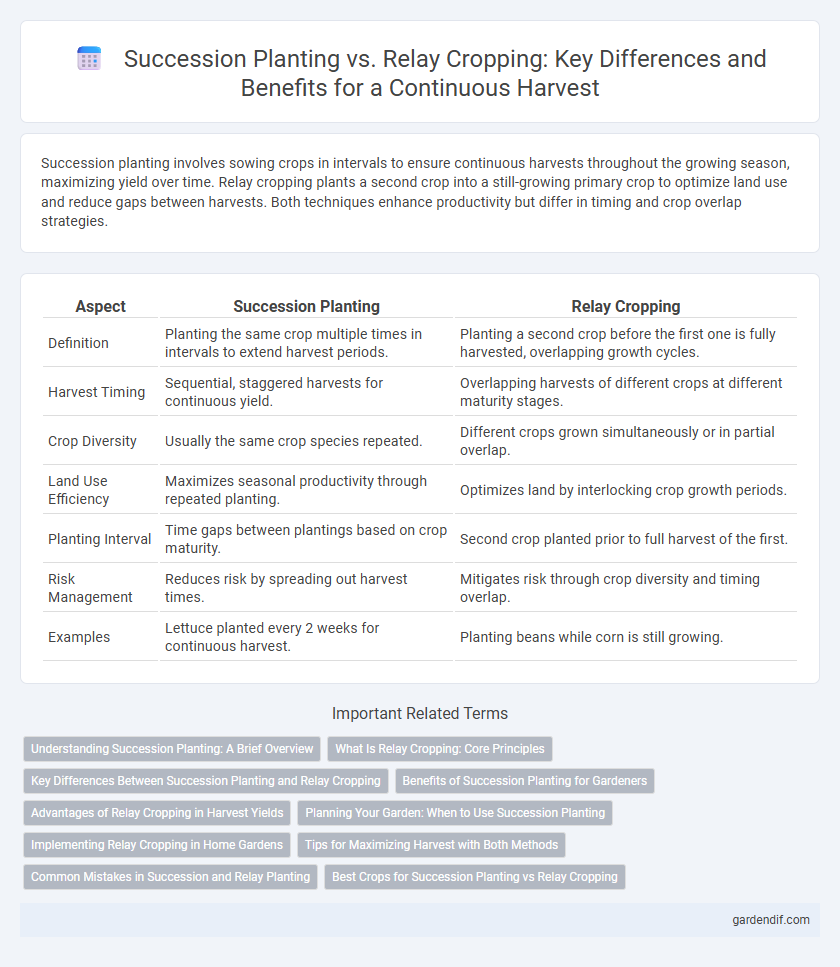
Succession Planting vs Relay Cropping Illustration
Succession planting involves sowing crops in intervals to ensure continuous harvests throughout the growing season, maximizing yield over time. Relay cropping plants a second crop into a still-growing primary crop to optimize land use and reduce gaps between harvests. Both techniques enhance productivity but differ in timing and crop overlap strategies.
Table of Comparison
| Aspect | Succession Planting | Relay Cropping |
|---|---|---|
| Definition | Planting the same crop multiple times in intervals to extend harvest periods. | Planting a second crop before the first one is fully harvested, overlapping growth cycles. |
| Harvest Timing | Sequential, staggered harvests for continuous yield. | Overlapping harvests of different crops at different maturity stages. |
| Crop Diversity | Usually the same crop species repeated. | Different crops grown simultaneously or in partial overlap. |
| Land Use Efficiency | Maximizes seasonal productivity through repeated planting. | Optimizes land by interlocking crop growth periods. |
| Planting Interval | Time gaps between plantings based on crop maturity. | Second crop planted prior to full harvest of the first. |
| Risk Management | Reduces risk by spreading out harvest times. | Mitigates risk through crop diversity and timing overlap. |
| Examples | Lettuce planted every 2 weeks for continuous harvest. | Planting beans while corn is still growing. |
Understanding Succession Planting: A Brief Overview
Succession planting involves staggered sowing of crops to ensure continuous harvests, maximizing garden productivity throughout the growing season. This technique optimizes space and time by planting new crops as soon as previous ones are harvested, reducing soil exposure and increasing yield. Common examples include planting fast-maturing vegetables like radishes followed by slower-growing ones such as tomatoes, maintaining a steady food supply.
What Is Relay Cropping: Core Principles
Relay cropping involves planting a second crop into a standing crop before it is harvested, ensuring continuous use of land and resources. This method optimizes soil nutrient use and improves overall yield by overlapping crop growth cycles, reducing fallow periods. Core principles emphasize timing, crop compatibility, and management of resource competition to maximize productivity.
Key Differences Between Succession Planting and Relay Cropping
Succession planting involves sowing the same crop at regular intervals to ensure a continuous harvest throughout the season, optimizing space and labor efficiency. Relay cropping entails planting a secondary crop in an existing crop before the first is harvested, maximizing land use and reducing fallow periods. Key differences include timing of planting and crop overlap, with succession planting focusing on staggered sowing of the same species and relay cropping promoting simultaneous growth of different crops in shared space.
Benefits of Succession Planting for Gardeners
Succession planting benefits gardeners by ensuring a continuous harvest, maximizing space efficiency, and reducing gaps between crop cycles. This technique promotes steady vegetable availability, improving garden productivity and reducing pest buildup by staggering planting dates. Gardeners can enjoy fresher produce and better resource management throughout the growing season.
Advantages of Relay Cropping in Harvest Yields
Relay cropping enhances harvest yields by allowing multiple crops to grow simultaneously in the same field, optimizing land use and providing continuous ground cover. This method reduces soil erosion and improves nutrient cycling, leading to healthier plants and increased productivity. The staggered planting schedule also helps spread labor demands and mitigates risk from adverse weather, ensuring more stable and higher overall yields compared to traditional succession planting.
Planning Your Garden: When to Use Succession Planting
Succession planting maximizes continuous harvests by staggering crop sowing at planned intervals, ensuring fresh produce throughout the season. Ideal for fast-growing vegetables like lettuce, radishes, and spinach, this method fits well in small gardens needing consistent yield. Timing is crucial--start new seeds just as earlier crops mature to maintain soil fertility and optimize space without overlapping harvesting periods.
Implementing Relay Cropping in Home Gardens
Relay cropping in home gardens involves planting a new crop before the current one is fully harvested, maximizing space and extending harvest periods. Implementing relay cropping requires selecting compatible crops with staggered growth cycles to ensure continuous soil cover and optimize sunlight and nutrients. This method increases garden productivity by reducing idle soil time and providing a steady supply of fresh produce throughout the growing season.
Tips for Maximizing Harvest with Both Methods
Succession planting involves staggered planting of the same crop at intervals to ensure continuous harvest, while relay cropping overlaps planting times of different crops to optimize land use. To maximize harvest, choose fast-maturing varieties for succession planting and time the planting so the second crop is established before the first is harvested. In relay cropping, select crops with complementary growth habits and nutrient needs to reduce competition and improve overall yield.
Common Mistakes in Succession and Relay Planting
Common mistakes in succession planting include improper timing between crops, leading to nutrient depletion and reduced yields. In relay cropping, errors often arise from overlapping growth stages without adequate space or resource management, causing competition and stunted development. Both practices require precise planning of planting intervals and crop selection to optimize harvest efficiency and soil health.
Best Crops for Succession Planting vs Relay Cropping
Succession planting thrives with fast-maturing crops like lettuce, radishes, and spinach, which allow multiple harvests in a season. Relay cropping suits complementary plants such as corn followed by soybeans, maximizing land use by overlapping growth periods. Choosing crops with compatible growth cycles and nutrient needs enhances yield efficiency in both planting methods.
Succession Planting vs Relay Cropping Infographic

 gardendif.com
gardendif.com